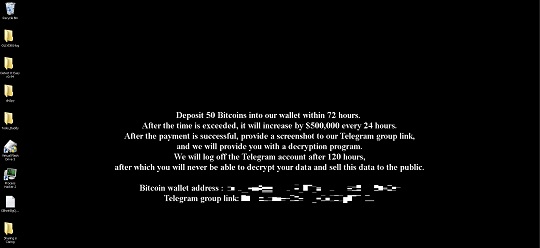Ransom.Win32.KASSEIKA.YPDLDT
Windows

Threat Type:
Ransomware
Destructiveness:
No
Encrypted:
Yes
In the wild::
Yes
OVERVIEW
It arrives on a system as a file dropped by other malware or as a file downloaded unknowingly by users when visiting malicious sites.
TECHNICAL DETAILS
Detalles de entrada
It arrives on a system as a file dropped by other malware or as a file downloaded unknowingly by users when visiting malicious sites.
Instalación
Termina su ejecución cuando encuentra los siguientes procesos en la memoria del sistema afectado:
- ntice.sys
- iceext.sys
- Syser.sys
- HanOlly.sys
- extrem.sys
- FRDTSC.SYS
- fengyue.sys
- Kernel Detective
- CisUtMonitor
- FileMonitor.sys
- REGMON
- regsys
- sysregm
- PROCMON
- Revoflt
- Filem
Otras modificaciones del sistema
Este malware establece la imagen siguiente como fondo de escritorio del sistema:
- %Program Data%\CBhwKBgQD.bmp
- %All Users Profile%\CBhwKBgQD.bmp

Otros detalles
Hace lo siguiente:
- It terminates itself if found the following window name in the affected system:
- OLLYDBG
- GBDYLLO
- pediy06
- RegmonClass
- Registry Monitor - Sysinternals: www.sysinternals.com
- 18467-41
- FilemonClass
- File Monitor - Sysinternals: www.sysinternals.com
- PROCMON_WINDOW_CLASS
- Process Monitor - Sysinternals: www.sysinternals.com
- It attempts to terminate running processes using the Restart Session Manager to encrypt the associated file as such will result to the following registry modification:
- RegKey: HKEY_CURRENT_USER\Software\Microsoft\RestartManager\Session{numbers}
Owner = {hex values} - RegKey: HKEY_CURRENT_USER\Software\Microsoft\RestartManager\Session{numbers}
SessionHash = {hex values} - RegKey: HKEY_CURRENT_USER\Software\Microsoft\RestartManager\Session{numbers}
Sequence = 0x01 - RegKey: HKEY_CURRENT_USER\Software\Microsoft\RestartManager\Session{numbers}
RegFiles{numbers} = {encrypted path andfile} - RegKey: HKEY_CURRENT_USER\Software\Microsoft\RestartManager\Session{numbers}
RegFilesHash = {hex values}
- RegKey: HKEY_CURRENT_USER\Software\Microsoft\RestartManager\Session{numbers}
- It reads the following registry keys to check for the BIOS version of the affected system:
- HKEY_LOCAL_MACHINE\HARDWARE\DESCRIPTION\System\SystemBiosVersion
- HKEY_LOCAL_MACHINE\HARDWARE\DESCRIPTION\System\VideoBiosVersion
SOLUTION
Step 2
Los usuarios de Windows ME y XP, antes de llevar a cabo cualquier exploración, deben comprobar que tienen desactivada la opción Restaurar sistema para permitir la exploración completa del equipo.
Step 3
Note that not all files, folders, and registry keys and entries are installed on your computer during this malware's/spyware's/grayware's execution. This may be due to incomplete installation or other operating system conditions. If you do not find the same files/folders/registry information, please proceed to the next step.
Step 4
Reiniciar en modo seguro
Step 5
Eliminar esta clave del Registro
Importante: si modifica el Registro de Windows incorrectamente, podría hacer que el sistema funcione mal de manera irreversible. Lleve a cabo este paso solo si sabe cómo hacerlo o si puede contar con ayuda de su administrador del sistema. De lo contrario, lea este artículo de Microsoft antes de modificar el Registro del equipo.
- In RegKey: HKEY_CURRENT_USER\Software\Microsoft\RestartManager\Session{numbers}
- SessionHash = {hex values}
- SessionHash = {hex values}
- In RegKey: HKEY_CURRENT_USER\Software\Microsoft\RestartManager\Session{numbers}
- Sequence = 0x01
- Sequence = 0x01
- In RegKey: HKEY_CURRENT_USER\Software\Microsoft\RestartManager\Session{numbers}
- RegFiles{numbers} = {encrypted path and file}
- RegFiles{numbers} = {encrypted path and file}
- In RegKey: HKEY_CURRENT_USER\Software\Microsoft\RestartManager\Session{numbers}
- RegFilesHash = {hex values}
- RegFilesHash = {hex values}
Step 6
Buscar y eliminar estos archivos
- {encrypted directory}\CBhwKBgQD.README.txt
- %Program Data%\CBhwKBgQD.bmp
- %All Users Profile%\CBhwKBgQD.bmp
- {encrypted directory}\CBhwKBgQD.README.txt
- %Program Data%\CBhwKBgQD.bmp
- %All Users Profile%\CBhwKBgQD.bmp
Step 7
Reinicie en modo normal y explore el equipo con su producto de Trend Micro para buscar los archivos identificados como Ransom.Win32.KASSEIKA.YPDLDT En caso de que el producto de Trend Micro ya haya limpiado, eliminado o puesto en cuarentena los archivos detectados, no serán necesarios más pasos. Puede optar simplemente por eliminar los archivos en cuarentena. Consulte esta página de Base de conocimientos para obtener más información.
Step 8
Restore encrypted files from backup.
Did this description help? Tell us how we did.

